A successful climb to Mount Yunam , and the unbelievable survival of a lucky mountaineer who spent a night at 5,500 meters without a tent and sleeping bag, in freezing -10°C temperatures.
The Summit of Resilience: A Harrowing Journey to Mt. Yunam

Introduction.
Over the past two decades, mountains have transformed into a playground for city dwellers seeking to reconnect with nature’s wilderness. However, we mustn’t underestimate the mountains but rather understand and respect their environment. The mountains are fragile, dynamic, and sometimes dangerous, but they remain an endless source of awe and wonder. To truly connect with nature, we must approach it with the mindset of learning and evolving.
Mt. Yunam is one of the most prominent peaks in the climbing community due to its relatively non-technical approach. In recent years, many mountaineers have aimed to summit Yunam as their first 6000-meter peak or a high-altitude expedition to kickstart their mountaineering journey.
Located at an altitude of 6111 meters in the Lahaul region of Himachal Pradesh, Yunam is known for its sparse vegetation, moraines, steep ascents, and rugged terrain. From the summit, one can enjoy panoramic views of the CB and Mulkila Ranges, along with vistas stretching to Zanskar.
The Journey Begins: Setting Out for Mt. Yunam
On 23rd September 2024, Team Sherpa Escapes. embarked on the Yunam expedition with a team of nine members—six climbers, Three Mountaineers aims to Summit of Mount Yunam
We began our journey by traveling from Manali to Keylong, a scenic three-hour drive with a quick tea stop in Sissu. The drive passed through Solang Valley and the Atal Tunnel, offering breathtaking views of Hanuman Tibba, Friendship Peak, Shikhar Beh, Mukhar Beh, and the Chandra River, which flowed alongside us. The weather seemed perfect, and the team was in high spirits as we prepared for the rest of our journey.
Around 7 kilometers before Keylong, we made a pit stop at Tandi, a small hamlet where the Chandra and Bhaga rivers converge. This confluence forms the Chandrabhaga River, which also marks the origin of the massive CB Range.
Arriving in Keylong was a welcome experience, as the hospitality was outstanding and the local food exceeded our expectations. We settled at Juniper Valley Camps, run by Tashi Acho, a local from Keylong. As part of our acclimatization process, we took a 5-kilometer hike to Sasur Gompa, a monastery situated above the town. From the monastery’s rooftop, we enjoyed stunning views of Keylong Peak, Ramjak, Goplang Goh, and the surrounding valley. After returning to base, we held a quick team briefing following dinner, and everyone retired for the night.
The Journey to Base Camp:
The next day, 24th September 2024, we had an early breakfast and set off at 9 AM from Keylong to Bharatpur, the base camp for our Mt. Yunam expedition. The 70-kilometer drive took us approximately five hours, passing Deepak Tal, Suraj Tal, and the mighty Baralacha Pass. We took our time to acclimatize by taking breaks along the way, enjoying tea and snacks, and stopping to capture some scenic shots. For many of us, it was our first time on the Manali-Leh highway, and the views were mesmerizing.
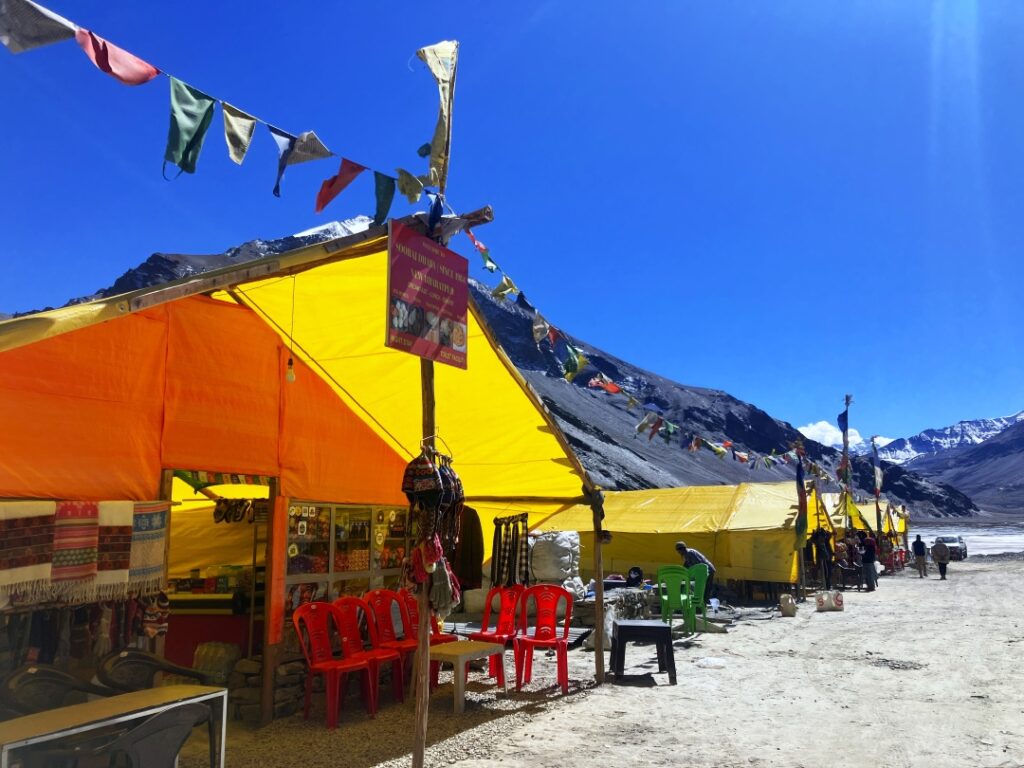
Bharatpur, a tent colony based at 4750 meters primarily inhabited by Nepalese migrants, is a small community where tea houses and restaurants provide food and lodging for travelers. The route is operational from June to October and closes during the winter months. These small businesses serve delicious meals to trekkers and truck drivers who pass through the area.
By 2 PM, we could see our base camp ahead. However, about 1.5 kilometers before we reached it, we encountered a friend—one of the supporting staff from another group. He was with a guide and a porter, and we stopped to chat briefly. He shared some troubling news that made us all uneasy.
This other group, consisting of 10 members (1 local guide, 1 porter, 1 cook, 1 supporting staff, and 6 clients), had arrived at the base camp a day before us (on 23rd September). When we met our friend, they had just returned from their ascent to the Advance Base Camp (ABC), which is situated at 5200 meters. According to the information, one of their clients had insisted on staying at ABC for a while and descending back to the base camp on his own. Despite some initial resistance, the guide and other team members had agreed to leave him behind and descend back to the base camp.
The trail from the base camp to ABC is relatively straightforward, a mix of scree and moraines with a gradual ascent. The main challenge comes after noon when crossing the river becomes more difficult due to rising water levels, requiring caution and skill. We were hopeful that the client would descend safely on his own, as he was carrying only a light day pack. The weather, though cold at night (dropping to -10°C), was clear and calm during the day, with temperatures ranging from -8 to -10°C. The only concern was the river, which was growing larger with each passing hour. After settling into a tea house in Bharatpur, run by a local Nepalese family, we rested. We always choose to stay here as we believe in supporting the local community while also getting much-needed rest. The family’s hospitality is unmatched, and we often help them during busy times, especially when groups of bike riders stop by for lunch.
Unexpected Challenges: A Stranded Client and a Race Against Time
Team Sherpa Escape was led by myself Rajesh Giri (Founder of Sherpa Escape) and Virendra Panwar (Professional Mountaineer from Uttarakhand – from Himalay ), and we made sure that all members acclimatized well and remained physically fit and mentally stable. This was the first day that we entered the high-altitude zone, which also meant we were now in a no-network area. For lunch, we had dal, rice, and salad, and we ensured that no one took a nap. Instead, we encouraged everyone to take a walk around to adapt to the weather and environment.
Around 5 PM, we set off for a casual walk towards the base camp, where most of the trekking agencies had set up their campsites. Our friend, whom we had met earlier in the afternoon, was also based there with his group. Upon arriving, we received concerning news—the client who had stayed behind at the Advance Base Camp (ABC) had not yet descended, and it was almost dark. With no means of communication between the guide and the client, everyone assumed he would return before dinner. We learned that the client was a 26-year-old student from Bengal, with prior experience on three treks, and this was his first attempt at a 6000-meter peak. After a brief discussion, we were offered tea by the cook, Jimmy, and then we returned to our own base camp.
As it was our first night at this altitude, some team members started showing signs of Acute Mountain Sickness (AMS). A few members refused to have dinner, while two others suffered from vomiting and headaches. The rest of the team seemed to be doing fine, but the cold was intense, with temperatures dropping to -7°C. Fortunately, we had a good place to sleep, with extra blankets provided, and the Nepalese family took great care to ensure we stayed warm throughout the night. They gave us plenty of warm water and soup to help us stay comfortable.
The Rescue: A Life-Saving Effort in the Mountains
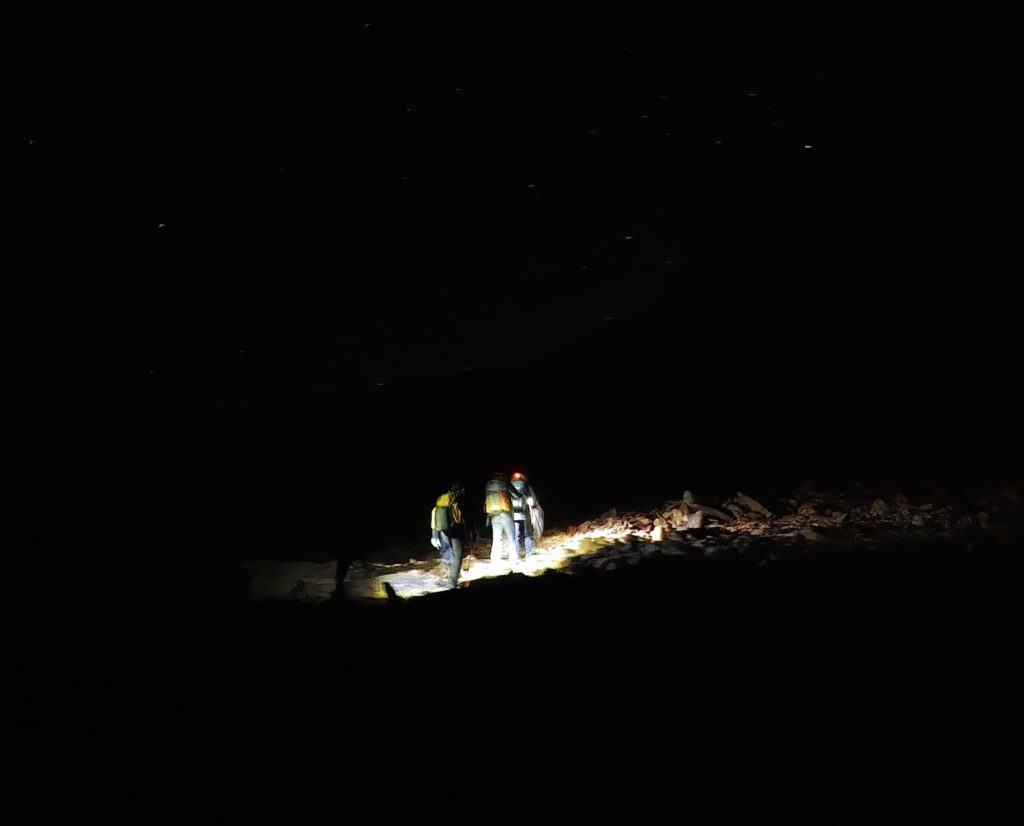
By around 10 PM, we were getting ready to sleep when we suddenly saw the guide and our friend from the other group rush towards us, looking terrified and agitated. They had come to ask for help, and we quickly learned that the client who had stayed behind at ABC had still not returned. This was the moment we knew we had to act fast. I and Linto decided to move out immediately, taking all the necessary technical gear, including ropes, while Virender had to stay back to look after the rest of the team as 3 of them were having AMS. We needed someone to care for the members who were unwell and ensure their safety.
When we reached the trailhead to ABC, the entire expedition team had gathered there. We quickly held a briefing to assign roles and responsibilities. We decided to move up towards ABC with four members: Mr. Chander Lal (the guide), Jimmy (the cook), Rajesh, and Linto (the assisting team). The other team had poorly organized logistics—no backup vehicle or communication equipment—so we made use of our van to transport the necessary gear and our UHF radios to maintain communication.
At 10:20 PM, we began our ascent, using whistles and shouting, as well as signaling with SOS flashlight signals, but there was no response. We split into two groups and continued up towards ABC, but we found no signs of the missing client. After more than three hours of searching at ABC and exhausting all possible routes, we realized we had to make a difficult decision: to descend and reach the nearest network zone to inform the authorities.
We made our way back to the roadhead, where it was pitch dark and cloudy. Using our van, we drove up to Killing Sarai, which is 7 kilometers from Bharatpur towards Sarchu, as it was the nearest place where we could get network access. Atul, our van driver, was a tremendous support that night, driving up and down safely and actively participating in the mission. Once we reached the network zone, the guide and our friend immediately contacted the agency owner to report the situation.
However, they should have contacted the nearby police station directly, as it would have been the most effective way to get immediate assistance. The conversation between our friend and the agency owner took place in Bengali, which made it difficult for us to fully understand. From what we gathered, the agency owner had reported the incident to the authorities, and a rescue team was reportedly on its way to help.
The news that the authorities were on their way gave us a renewed sense of hope, and we felt stronger knowing that more manpower would be on the way to assist in the rescue. As we headed back towards the base camp, we passed our settlement where Virender was alone, looking after the five remaining members. We learned that three of them were severely ill with AMS, and one was getting worse. Realizing the urgency of the situation, we decided to stop there, and Atul continued on with the van to the base camp of our friend.
At 6 AM, the situation worsened as two of our team members were recovering, but the rest were becoming more severe with their health. Just then, we saw Atul rush towards us, accompanied by the guide and our friend from the other team. We learned that no help had come from the authorities the previous night. The client who had been stranded at ABC for the past 20 hours was still alone, with no proper clothing, food, shelter, or means of communication. This news escalated the urgency of the situation, and we immediately headed to Killing Sarai. There, we instructed the guide to make a direct call to the police department.
The guide contacted the authorities, and we also reached out to the Keylong Police Department, which was the closest. By around 10 AM, a rescue team was dispatched to the base camp. A team of seven set out for ABC, and they eventually located the client on the opposite side of the trail, heading towards the summit. He was found taking shelter under a rock and waving his hand for help. The team rushed to him, and after providing immediate assistance, they safely escorted him back to the base camp.
Upon returning to the base, the authorities conducted an inquiry, and every detail of the situation was carefully documented. The client, who had been stranded on the mountain for more than 24 hours, shared his account of the ordeal. He explained that after the team left for the load ferry, he decided to stay behind at ABC for a while. At that moment, he made the decision to attempt the summit and began his ascent. However, he soon lost the trail and reached a critical point, where he found himself at a cliff with no way to move forward. Realizing he couldn’t go any further, he started to descend, but being off-track, he had no clear path and was forced to slide down in a sitting position.
By the time darkness set in, he found a rock Bellow the Summit of Mount Yunam, where he took shelter for the night. Unfortunately, he also realized that his phone had run out of battery, leaving him without any means of communication or signal. According to the terrain he described and his location, it became clear that the client had gained 480 meters from the advance camp. This made the search more challenging the previous night, as his position was difficult to pinpoint.
The client was given appropriate medication and received excellent care from the team. After the police completed their investigation, it became clear to everyone that the expedition had been undertaken without the necessary permit and without any communication equipment. The clients were furious with the agency, and their anger grew when they learned that the agency had failed to inform the police the previous night. The agency’s failure to act promptly was seen as a fear of getting into trouble, while they had completely disregarded the life of the client stranded on the mountain for over 20 hours.
After the successful rescue by the authorities, the expedition was officially called off by the clients. With the safe return of the stranded client to the base and after learning about the agency’s carelessness, the clients decided to leave for Manali as soon as possible. They also made the decision to take legal action against the agency owner for their negligence.
After the police gathered all the necessary information from the team, they issued a strict warning against conducting any trekking or climbing expeditions without proper permits and planning. The worst part of the situation came when we asked our friend about the conversation he had with the agency owner that night. He revealed that the owner had given clear instructions to leave the client behind and return to Manali, telling the team to claim that they only had five clients if questioned by the police. If anything happened, the owner advised them to deny any knowledge of the situation.
When this information came to light, it was deeply shocking and infuriating. We couldn’t believe that such companies were operating with no regard for human life. Mr. Chander Lal, the local guide from Banjar, pulled us aside and shared that he had been blamed for the situation, despite the client insisting on staying at ABC after a dispute with the team. The client argued that since he had paid for the expedition, the team had no right to stop him from continuing.
In short, the entire experience made us realize that it was a disorganized expedition, and everyone involved had to suffer as a result. The only positive outcome was that a life was saved.
Successful Summit of Mount Yunam: Overcoming Obstacles and Reaching the Peak
Our friend and his team saw their vehicle arrive, and they left for Manali. We returned to our base and checked on our team. Three members were fit and ready to prepare for the summit push, while the other three had decided to stay back and were steadily improving in health. Achuk from the Nepalese family, who was well-versed in handling medical conditions, took responsibility for the three members who were staying behind. We also took their vitals before settling in for the night to ensure they were stable.
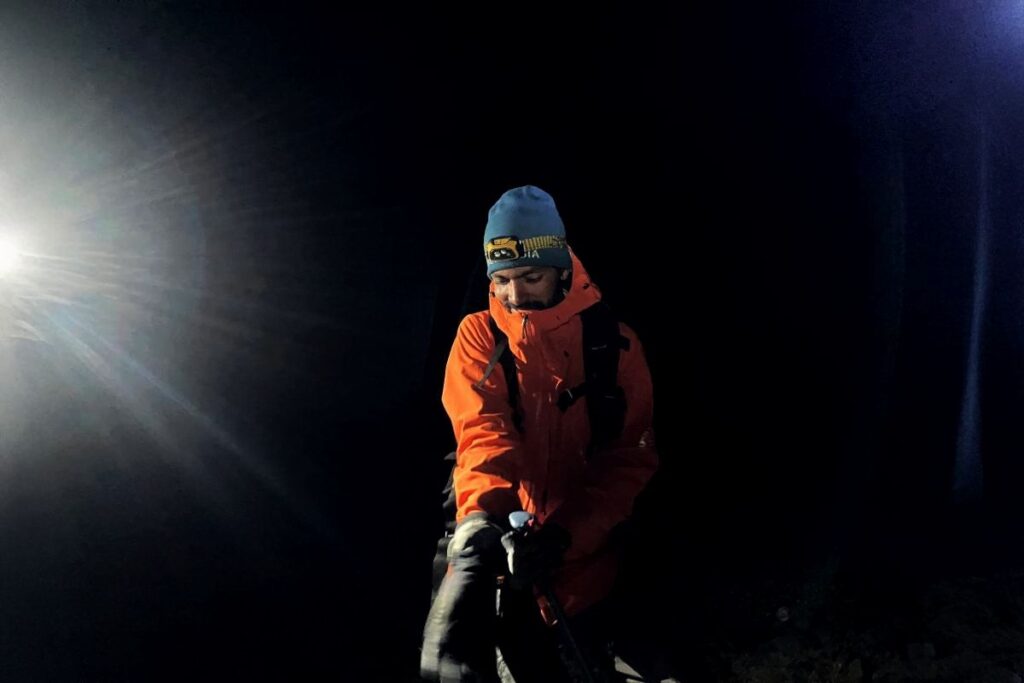
The next morning, at around 4:30 AM on 26th September, we began our push to Summit of Mount Yunam directly from the base camp, with two guides and three climbers. Atul drove us to the starting point from our base. We packed light backpacks with all the necessary gear, including our walkie-talkies and one extra PC with Atul. We made it to ABC in three hours, although two of our members were moving slower. During the hike, we noticed a light moving on the opposite side of the river, which immediately suggested that it might be someone attempting a solo climb and possibly off-route. We signaled to them and directed them to the correct path.
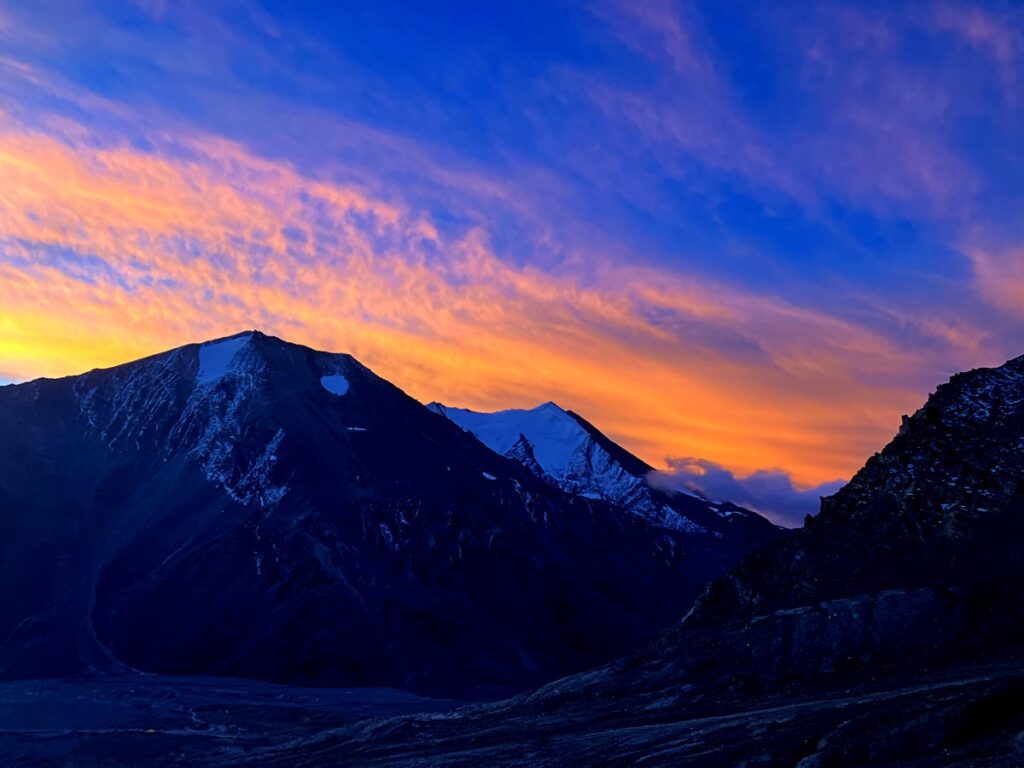
By around 6 AM, we reached ABC, and one of our members began showing signs of exhaustion and fatigue. He was also carrying camera lenses and drones, which made his pack considerably heavier. After arriving at ABC, we decided it was best for him to stop there, and we gave him clear instructions to descend. Atul was notified via walkie-talkie about his situation, and he was on his way to retrieve him.

A Hard-Earned Return: Lessons Learned and Moving Forward
The daylight had already broken, and the sun was beating down on us, making every step feel exhausting. We found ourselves resting every 100 meters to keep up our strength. One of the clients was pushing his limits, determined to keep going, knowing that turning back wasn’t an option due to the harsh weather forecast in the coming days. We moved together, ensuring that everyone stayed in good health and avoided any dangerous conditions. By the time we reached the summit camp at 9 am, the sun was becoming relentless. We took a short break to hydrate and refill our water from a minor stream flowing to the left of the trail.
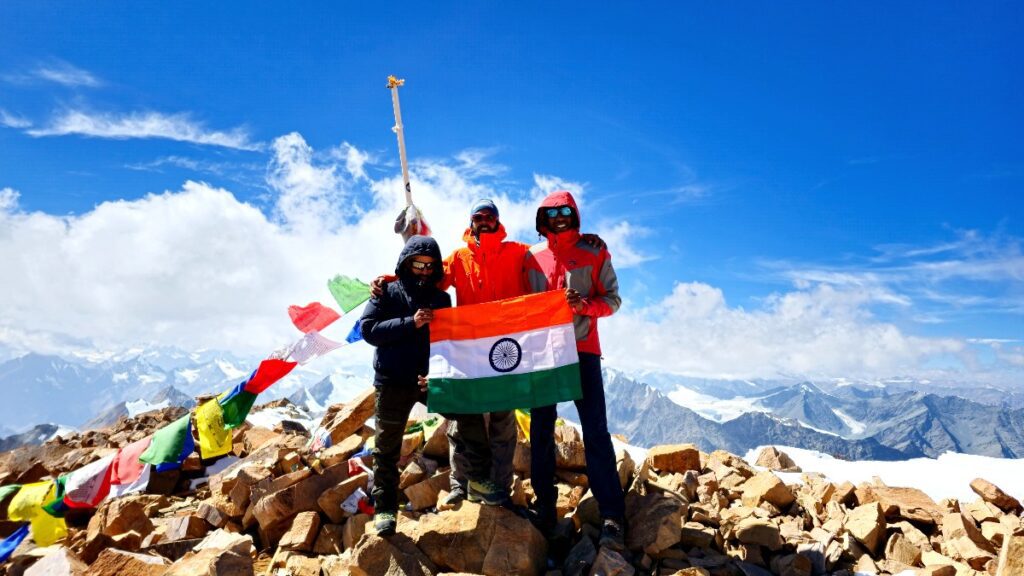
We had some oranges, dry fruits, and protein bars to sustain us, but the warmth forced us to strip off our down jackets and settle into lighter gear to make the climb easier. As we neared the icewall patch, the sight of the summit pole with waving flags brought smiles to our faces, but the distance to it remained unchanging as we ascended further. Once we reached 6000 meters, our pace slowed significantly, but we pressed on. One of the clients was struggling, but after checking his vitals and ensuring he was in good health, he agreed to continue. Virender led the way while Rajesh stayed back with the clients. We eventually reached the final 70-meter stretch, where we knew the summit was within reach.
Virender made it to the summit first at 1:02 pm, followed by the other members at 1:24 pm. The moment was filled with joy, especially as three members celebrated their first 6000-meter summit, while Rajesh reached the top of Yunam for his fourth time in 2024. Though the weather turned cloudy, the wind was manageable, and we were treated to a stunning panoramic view of glaciers and surrounding peaks, including the SPiti region, Pin Valley, Parvati Valley, Mulkila Range, CB Range, Zanskar Range, and the Karakoram Range. After spending 20 minutes at the summit, taking photos and celebrating the achievement with hugs, we savored the breathtaking views of several 6000-meter peaks and five visible lakes. The summit was a testament to the entire team’s hard work and determination, symbolizing their skills and accomplishments.
We began our descent and made it back to the base by 5 PM. Upon arriving at the settlement, we were warmly greeted by the Anchuk from a Nepalese family and the other team members, who congratulated us with a hot cup of tea. After packing our bags and enjoying some noodles, we hit the road and started our drive back to Manali that same evening.
Teamwork, Safety, and Preparation: The Key to Mountaineering
The entire experience, from the challenges faced to the triumph of reaching the summit, was a powerful reminder of the importance of perseverance, teamwork, and respect for the mountains. It’s not just about reaching the peak but the lessons learned along the way—the strength to push through, the courage to make difficult decisions, and the ability to adapt in the face of uncertainty.
Mountaineering is a beautiful yet unforgiving pursuit, and safety must always be the top priority. Proper planning, the right permits, effective communication, and most importantly, listening to your body and your team are crucial for success in the mountains. This expedition has reinforced the value of preparation, caution, and always being aware of the unpredictable nature of the environment.
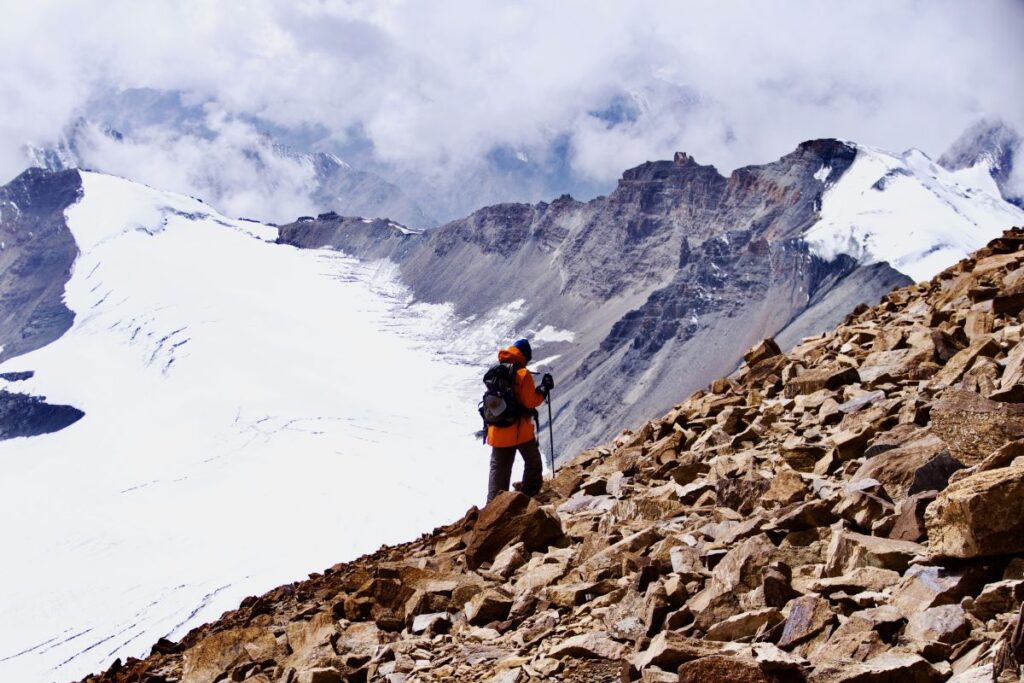
At the end of the day, the mountains don’t just challenge our physical abilities—they test our mental resilience. Whether we reach the summit or not, every step taken is an opportunity to grow, learn, and connect with nature in ways that are beyond words. The journey is just as important as the destination.
